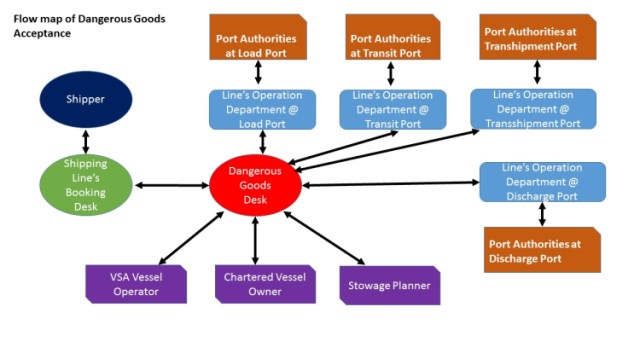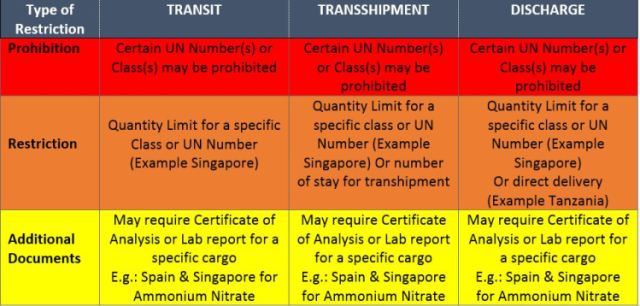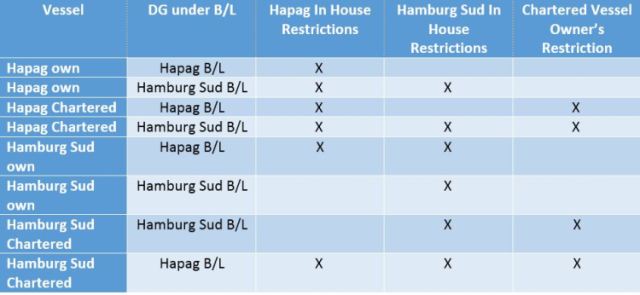World over most shippers are in dark wondering what makes the delay for a shipping line to revert with acceptance of a dangerous goods shipment request or what checks are being done at shipping lines’ dangerous goods approval desk.
This article is an overview of information flow of dangerous goods shipments for ocean carriage and checks done at Line’s approval desk of big shipping companies who has global presence.
Geographical Desks
Generally global lines have three separate DG desks (Dangerous Goods Department) for handling dangerous goods shipment requests. These desks handle booking requests for loading within a defined geographical area.
Below table is representative geographical distribution areas of each DG desk within a Shipping Line.

These regional desks will be situated in said regions. Example Asia DG desk in Singapore or Hong Kong, Europe DG Desk in London, Hamburg or Marseille, America DG desk in New York or Charleston.
Some Lines have consolidated these three DG desks into one single office however working in same manner 24 hours x 5 days. Example offshored DG desk situated in India.
Within the same office DG approvers (Person who verify shipper’s declaration for compliance to regulations) may be looking after certain trade lanes not the entire area. Example: One DG approver handling Asia Europe and Asia North America, another handling Asia South America and Asia/Africa.
Information Flow
Below is the standard information/process flow of dangerous goods shipments for ocean transport (not in exact sequential order), there may be minor variations for different lines or when shipper uses his own equipment etc.
- Shipper submit details to local booking desk
- Booking Desk submit DG details to respective DG Approval desk (as in above table)
- DG Approval desk verifies booking details against IMDG Code, Port Rules and send requests, when needed, to transit Transshipment ports
- DG Approval desk send request to other lines when loading on their ships ( VSA- Vessel Sharing Agreements)
- DG Approval desk checks with stowage planners ( only for certain commodities and or smaller vessels)
- DG Approval desk flags each acceptances received ( form ports, vessel partners and stowage planners)
- DG Approval desk approves the booking when all acceptances are in hand
- Booking desk Informs shipper about acceptance
- Booking Desk make request to local transporters (trucks/railway/barge operators) for export pickup and delivery at first load port
- Equipment yard delivers empty container
- Transporter Picks up empty container to shipper
- Unit stuffed and shipper submit final DG Declaration Form to booking desk
- Booking desk submit DG declaration to vessel for loading
- Container moved to first ocean load port for loading
- Stowage Planner plan the vessel as per Document of Compliance, IMDG Code and in house restrictions.
- Unit loads when vessel arrives
- Import Desk make request to local transporters (trucks/railway/barge operators) for delivery based on import manifest.

Above looks very straight forward and simple but in reality information flows back and forth for clarification and correctness with compliance to IMDG Code, National Regulations etc. and may be rejected too.
DG Approval Desk – Activities
- Cross checking details submitted by shipper with respect to IMDG Code requirements
This is generally done like a proof reader’s job. Example: Shipper submitted details of packaging as Plastics non-removable drum, IMDG Code packing instruction for said UN Number allows same, if not booking is rejected.
Similar way DG approver checks compliance with IMDG Code for
– Type of packaging ( drums, boxes, bags, jerrycan, IBCs, tanks, cylinders, MEGCs)
– Material of packaging ( Plastics, Steel, Aluminium, Wooden, etc)
– Quantity per package
– Some lines look into inner packing details too ( though not mandatory by IMDG Code on declaration)
– Type of container ( Example: Reefer for flammable liquids, flashpoint, reefer setting, temperature controlled cargo control and emergency temperatures)
Port Approvals
DG Approver checks the UN Number in the booking against the policy of each port involved in the route through which the cargo will move from origin to destination. This will include Load, Transit, Transshipment and Discharge ports.
Port policies may vary from port to port and cargo to cargo. Some of the common restrictions are as below, however these restrictions are only applicable to certain UN Number or UN Class as per particular port’s restrictions:

First load port also may have restrictions, DG approver will check same.
Let us see an example how a DG approver checks the port rules. In order to keep it short we will check one commodity at Transshipment port Singapore.
Cargo: Ammonium Nitrate UN 1942 Class 5.1
Quantity: 5 x 20 ft container each having 20 tons net weight
Port or Loading: Hamburg
Transhipment : Singapore (PSA Terminal B01)
Port of Discharge: Busan
Singapore port regulations for Ammonium Nitrate (Click here for more details)

– DG Approver, through booking desk, ask Shipper for Certificate of Analysis
– Booking has 100 tons,
– Singapore limit is 400 tons
– DG Approver extracts a report from his/her computer application for all bookings made on the voyage and filter down ammonium nitrate bookings already accepted and pending through Singapore.
– If quantity of this booking will increase the total quantity more than 400 tons or certificate of analysis is not received said booking will be rejected.
Vessel Approval
There are three categories of vessels
- Own vessel
- Chartered Vessel
- VSA Vessel
Own Vessel Restrictions
Line’s own vessel the restrictions applicable are company’s house rule
Chartered Vessel Restrictions
When a shipping line is loading on chartered vessel charter party restrictions will be applicable.
Generally Charter Party restrictions are applicable for below commodities
– Ammonium Nitrate
– Calcium hypochlorite
– Explosives
– Fireworks
– Radioactive substances
If restricted by vessel owner the line need to submit each booking to vessel owner and await their go ahead before giving acceptance to Shipper.
VSA Vessel Restrictions
In VSA (Vessel Sharing Agreement) Dangerous Goods are divided into three groups:
- Embargoed Dangerous goods which will not be carried;
- Dangerous goods that require special requirement by Vessel Operator;
- General dangerous goods which involves standard application and approval procedure
When loading on VSA vessel approver will check Line’s own house rule and VSA’s house rule. The agreement is that a Line shall not offer to load a cargo which it restricts on own vessels to VSA or which is restricted on VSA vessel.
Below matrix is an example which restrictions are applicable if Hapag Lloyd and Hamburg Sud is in Vessel Sharing Agreement (VSA) and are loading DG on each other’s vessels

Turn Around Time (TAT)
How much time does it may take for a dangerous goods shipment request to get accepted?
This is a million dollar question debated by entire shipping community over decades with most still banging their heads on walls.
Sales and Customer Service team, without knowing how a DG request is processed by DG approvers, may give guarantee to shipper that they can get approval within 2 hours from the time of submission of request.
Shipper is overjoyed, he/she submit the booking expecting acceptance within promised 2 hours and may end up waiting and sending reminders for next two weeks.
What makes a booking to take so long to get accepted?
It all depends on the cargo, route, vessels involved etc. If the booking is of PAINT it may get accepted within an hour. If it is Ammonium Nitrate or Explosives it may take 15 days, sometimes more.
- Port acceptance may take 1 – 5 days due to time zone difference and their work load
- VSA vessel approval may take similar time
- Charted Vessel Owner’s Approval may take 5 – 15 days
Reference Books and Publications used for DG Acceptance
- IMDG Code
- 49 CFR
- TDG Canada
- ADR
- RID
- Other National Regulations when needed
- Hawley’s Condensed Chemical Dictionary (or similar)
- Chemical Weapon Convention ( Australia Group)
- UN Convention Against Illicit Traffic In Narcotic Drugs And Psychotropic Substances
- Bamaco, Basel, Rotterdam, Stockholm Conventions
- Montreal Protocol
- US Embargo
- EU Embargo
Conclusion
On a daily basis, for each geographical region, a vessel operator may have approximately 500 -800 bookings, including new bookings submitted by shippers on that particular day and bookings from previous days and older pending for ports, VSA or Charter Party Approval.
Some shipping lines prioritize the bookings as per earliest sailing date.
Some lines work like hens picking worms from ground, randomly. A booking which is sailing after 20 days may be accepted without delay but another booking which is scheduled to load in same week may remain pending with them.
Overall all shipping lines’ approval desks do an excellent job ensuring compliance to IMDG Code, National, International Regulations, Port Regulations, other applicable International Protocols and Conventions such as Basel, Rotterdam, Stockholm, Bamako Conventions, Montreal Protocol, Chemical Weapon Convention, United Nations Convention Against Illicit Traffic In Narcotic Drugs And Psychotropic Substances, EU/US Embargo to ensure safety of life at sea, prevention of pollution & legitimate business.
———————————————–
Above is an overview of work done at shipping lines approval desk, it actually involves more complicated process such as segregation checks (E.g. segregation and port restrictions for consol box “180 or more different UN Numbers in a single container”) and time consuming verification of various other criteria depending on FAK, Consoles, special cargoes, shippers, origin/ destination/trade route, in house rule, charter party agreement, VSA rules, Truck, Barge or Rail operator restrictions etc.
Shipper can never contact DG desk directly, communication is always routed through Booking Desk (Customer Service Team)

 WhatsApp your queries
WhatsApp your queries
thanks for the information… I have an shipment to be exported from chennai to Durban. The commodity is firework.. The have forwarded all relevant docs like MSDS, packing list , police permission at the destination to the liner. But the liner is asking for classification number and classification reference… I don’t have that.. can you please guide me how to go about it and get the acceptance from the liner..
Good Day Dinesh,
Firework classification reference is required in Dangerous Goods Declaration as per Section 5.4.1.5.15 of IMDG Code, this is issued by Competent Authority of India whom you may contact in below address.
Directorate General of Shipping, 9th Floor Beta Building,
i-Think Techno Campus, Kanjurmarg (East), Mumbai – 400 042 ( India )
Tel. No. : 91-22-25752040/41/42/43/45 Fax.No. :91-22-25752029/35; Email : dgship-dgs@nic.in
Regards/ Shashi